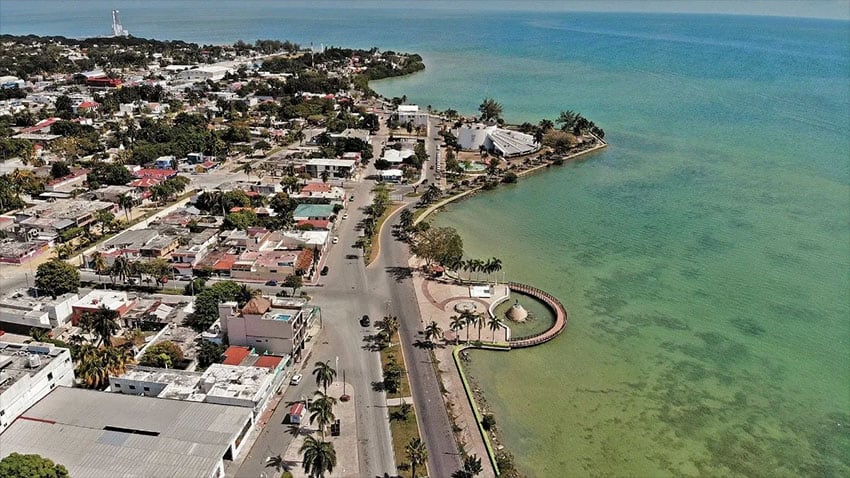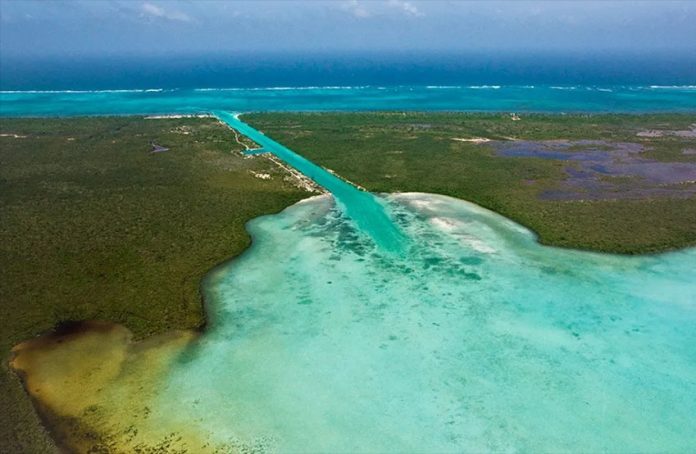At the southern end of the Costa Maya — less than 3 kilometers from the Mexico-Belize border — is a tiny canal that officials in Quintana Roo are trying to make into a bigger deal.
But it’s not working out very well.
Begun in 1901 during the government of Porfirio Díaz, the Zaragoza Canal is located on a thin peninsula — about 225 kilometers south of Tulum — that forms part of Chetumal Bay. If the canal and its surrounding waters were deep enough, it would allow cargo ships, cruise ships and large yachts to sail directly from the Caribbean Sea to Quintana Roo’s capital city of Chetumal without passing through Belizean waters.
With that enticement, state officials began a dredging project in 2019, just as they had done some two decades before. The aim is to spur tourism, boost commercial shipping and make it easier to get from Chetumal to the coastal village of Xcalak in an unspoiled corner of the Mexican Caribbean (for cruise ship excursions, among other reasons).
But according to a report in the newspaper Milenio, the attempts of the state government are “about to conclude” because the dredging efforts have “come up against a very hard bottom, made of flagstone.” The machinery being used is unable to break up most of those stone slabs.
The canal itself is 1.2 kilometers long and 50 meters wide, which is fine. But the depth of the artificial channel hardly exceeds 2 meters, and the depth of Chetumal Bay isn’t much better at 4 meters in many places, and shallower in others. Only small boats can navigate it, and another factor is this: Since there is no traffic, the bottom becomes silt.
So the goal of the 2019 project was to dredge a 4.8-kilometer channel off the canal, bringing the total length of the canal and channel to 6.3 meters, and deepening everything to at least 3 meters.
But the bottom isn’t budging. At least not much. “They have even used dynamite to destroy it,” Milenio wrote, but “that stone does not yield.”
The administration of Carlos Joaquín González, governor of Quintana Roo from 2016 until later this month (when two-time Cancún mayor Mara Lezama Espinosa will be sworn in) has “invested at least 400 million pesos (US $20 million) for this task,” Milenio reported.
“As much as possible was dredged,” said Hiram Toledo, commercial manager of the Quintana Roo Integral Port Administration. “It reached 2½ meters, almost 3 meters deep, [but] right now they need another type of machinery.”
Currently, only fishing boats, tourist boats or small yachts can enter the bay through the canal. To get cargo and cruise ships through, of course, more money will be needed.
And that’s beyond what would already cost US $42 million, according to Toledo: $25 million for a terminal with capacity for three cruise ships (for which a depth of up to 6 meters is needed); $2.5 million for a marina in Chetumal Bay for 56 yachts (up to 51 feet long); $12.5 million for ecotourism villages with 600 rooms; and $2.7 million for a cargo terminal.

Businessmen from Chetumal are insisting that, in the name of economic development, both state and federal governments invest in making the canal functional. If that were to happen, Chetumal could fully capitalize on its status as a transit city to Central America, said Eloy Quintal, president of the Business Coordinating Council of Chetumal.
“It has to do with the issue of facilitating trade, of expanding the possibilities that the city of Chetumal, strategically due to its border position, can commercially supply, through these routes,” he said.
Then again, Xcalak, the town closest to the canal, exists on low-impact tourism, such as sport fishing, diving and snorkeling, and people there do not welcome the idea of attracting bigger boats.
“They told us every day, ‘It will bring you good things. Xcalak will grow.’ But we are used to being lied to,” said Fortunato Herrera, a local resident.
Herrera also warned about the risk to the area’s Mesoamerican Barrier Reef, the largest barrier reef system in the Western Hemisphere, stretching nearly 700 miles from the Yucatán Peninsula along the coasts of Belize, Guatemala and Honduras. It is also known as the Great Mayan Reef.
“I don’t have much study, but I imagine that the United Nations [would] say, ‘Why are they breaking natural phenomena?’” said another Xcalak resident, Don Nato.
“The lagoon part of the reefs is not suitable for even a sailboat, because there is a lot of coral,” added another resident, Antonio Salazar. “In fact, some sailboats … have passed and have damaged many corals.”
With reports from Milenio
